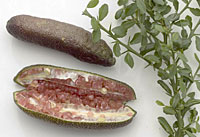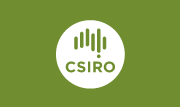Systematics and Evolution (HA)
Rutaceae
Citrus molecular studies
 Citrus australasica fruit
Citrus australasica fruit |
Project Leader: (Miller, Joe ^)
Molecular phylogenetics of the subfamiliy Aurantioideae, especially Citrus (staff: Cathy Miller, Ish Sharma). This study includes several strands. Initially cpDNA work lead by Randy Bayer will investigate relationships among aurantioid genera with a focus on Citrus. The classification of the group, especially the generic circumscriptions, will be reviewed. Molecular dating and biogeographic patterns will also be explored. This work will be extended to include more samples of non-Citrus aurantioids and a complete revision of the generic classification of the subfamily is envisioned.
The second strand of the aurantioid work is to explore nuclear DNA variation, especially among Citrus cultivars, wild species and relatives in closely allied genera such as Eremocitrus, Fortunella, Microcitrus, Poncirus. Multiple nuclear gene phylogenies are being generated to understand the complex inter-cultivar and wild species relationships within Citrus. Hybridisation has been a major component of Citrus breeding efforts, along with the preservation of near-primary hybridity through apomixis and vegetative propagation. This is an ideal group to explore the power of multiple nuclear genes and novel analysis methods to infer the history of these plants.
The third strand of work being carried out in Citrus is the testing of species boundaries among Australian native Citrus relatives using traditional and molecular taxonomic methods, including analysis of microsatellite variation. Recent work on cultivated Citrus using molecular data suggests that only a handful of species exist in the group. The variation promulgated by artificial selection in cultivated Citrus has made the application of traditional methods quite inconsistent (e.g., the the 15 or so species recognised by Swingle versus the 150 or species recognised by Tanaka). The molecular taxonomy is, however, much closer to groups that are inter-fertile, which suggests that these methods could be very useful in taxonomically confused groups. Native Citrus relatives have not been included in the molecular work so far. Some methods using molecular data are fairly recent and would benefit from thorough examination and comparison to traditional methods. The wild species that are found in Australasia appear to be free of artificial selection (apart from within the last decade or so) and therefore could be a good group to test the newer methods against traditional ones.
Research Goals:
- Citrus and Aurantioideae phylogeny based on 10kb of cpDNA sequence and the implications for classification
- Citrus phylogeny using multiple nuclear genes to examine past hybridisation and further inform classification decisions.
- Native Citrus species delimitation using molecular taxonomy
- Radiation of Australasian Citrus and subfamily Aurantioideae examined using molecular dating
.
|
![An Australian Government Initiative [logo]](/images/austgovt_canbr_90px.gif)

![An Australian Government Initiative [logo]](/images/austgovt_canbr_90px.gif)



